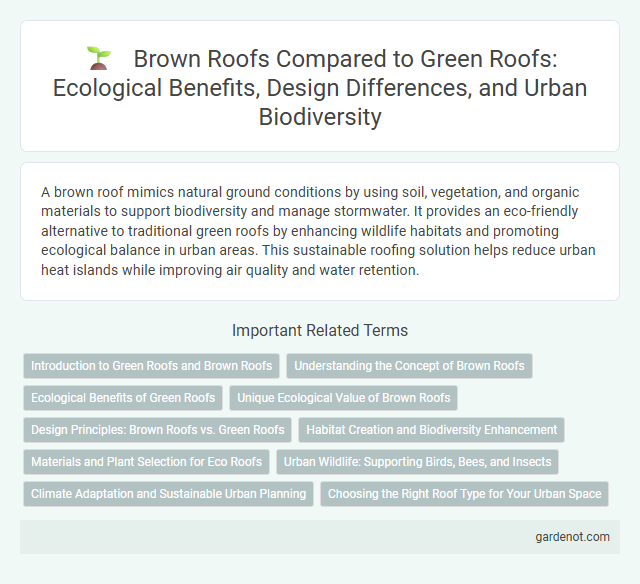A brown roof mimics natural ground conditions by using soil, vegetation, and organic materials to support biodiversity and manage stormwater. It provides an eco-friendly alternative to traditional green roofs by enhancing wildlife habitats and promoting ecological balance in urban areas. This sustainable roofing solution helps reduce urban heat islands while improving air quality and water retention.
Introduction to Green Roofs and Brown Roofs
Brown roofs are a sustainable alternative to traditional green roofs, designed to promote biodiversity by using native soil and materials to create wildlife habitats. Unlike green roofs that often feature extensive vegetation and intensive maintenance, brown roofs mimic natural ground conditions, supporting local flora and fauna with minimal irrigation and upkeep. These roofs contribute to urban ecology by enhancing habitat connectivity and improving stormwater management through natural absorption and filtration processes.
Understanding the Concept of Brown Roofs
Brown roofs are engineered green infrastructure designed to support biodiversity by mimicking natural, undisturbed habitats with minimal intervention. These roofs utilize locally sourced soil and native, non-irrigated vegetation such as grasses, wildflowers, and mosses to create a habitat for insects, birds, and other wildlife in urban environments. Understanding brown roofs involves recognizing their ecological value in enhancing urban biodiversity while requiring less maintenance compared to traditional green roofs.
Ecological Benefits of Green Roofs
Brown roofs enhance urban biodiversity by providing habitat for native flora and fauna, supporting pollinators and local wildlife. These roofs aid in stormwater management by absorbing and filtering rainwater, reducing runoff and alleviating pressure on drainage systems. They contribute to urban cooling through increased evapotranspiration, mitigating the heat island effect in densely built environments.
Unique Ecological Value of Brown Roofs
Brown roofs provide a unique ecological value by mimicking natural, undisturbed soil environments that support native flora and fauna. Unlike traditional green roofs, brown roofs promote biodiversity by creating habitats for invertebrates, birds, and insects through the use of locally sourced substrates and minimal disturbance. This approach enhances urban ecosystems by fostering species that thrive in raw soil conditions, contributing to ecological connectivity and resilience.
Design Principles: Brown Roofs vs. Green Roofs
Brown roofs utilize natural substrate and native vegetation to enhance local biodiversity, contrasting with green roofs that prioritize intensive plant coverage and irrigation systems. Design principles for brown roofs emphasize ecological integration, minimal maintenance, and habitat creation, whereas green roofs focus on stormwater management, thermal insulation, and urban greening. Both roof types contribute to sustainable urban environments, but brown roofs offer a low-intervention approach that supports wildlife and mimics native ecosystems.
Habitat Creation and Biodiversity Enhancement
Brown roofs simulate natural habitat substrates using inert materials to support native plants and wildlife, promoting urban biodiversity. By providing a suitable environment for insects, birds, and small mammals, brown roofs contribute significantly to habitat creation in city landscapes. These roofs enhance ecological connectivity and serve as crucial stepping stones for wildlife in fragmented urban areas.
Materials and Plant Selection for Eco Roofs
Brown roofs utilize locally sourced, inert materials such as gravel, bricks, and recycled rubble to create a substrate that encourages natural vegetation growth, promoting biodiversity in urban environments. Plant selection for eco roofs emphasizes native species and hardy grasses that can thrive in nutrient-poor, well-drained conditions typical of brown roof substrates. These materials and plant choices foster habitats for insects and birds, supporting ecological functions while requiring minimal maintenance.
Urban Wildlife: Supporting Birds, Bees, and Insects
Brown roofs enhance urban biodiversity by creating habitats that support birds, bees, and insects, promoting ecological balance in city environments. These roofs mimic natural soil habitats through a mix of substrate and native vegetation, providing essential nesting and foraging grounds for pollinators and bird species. Incorporating brown roofs into urban planning helps sustain local wildlife populations and encourages biodiversity within densely built areas.
Climate Adaptation and Sustainable Urban Planning
Brown roofs enhance climate adaptation by promoting biodiversity through native vegetation and natural materials, which improve urban heat island mitigation and stormwater management. Integrating brown roofs into sustainable urban planning supports resilient city ecosystems by reducing runoff and providing habitats for pollinators and birds. These roofs also contribute to carbon sequestration and improve air quality, aligning with green infrastructure goals for climate-resilient cities.
Choosing the Right Roof Type for Your Urban Space
Brown roofs offer a sustainable alternative for urban environments by supporting biodiversity through natural soil and vegetation layers that mimic local ecosystems. Selecting a brown roof ensures enhanced stormwater management and reduced urban heat island effects, making it ideal for city areas seeking ecological improvements. Prioritizing native plant species native to your region optimizes habitat creation and maintenance efficiency on brown roofs.
Brown roof Infographic

 gardenot.com
gardenot.com